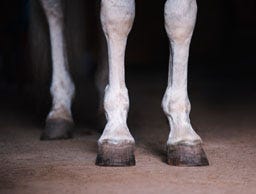Understanding Arthritis in Dogs
Many dogs will develop some kind of condition in their lifetime, typically as they get older, but some can affect dogs of any age. According to a study, 4 out of 5 older dogs will develop arthritis in their lifetime, and canine arthritis is the most common cause of chronic pain in dogs.
Just because your dog is diagnosed with arthritis doesn’t mean they can’t still live a fulfilled and happy life. In this article, we’re going to explain some of the key signs of arthritis in dogs, as well as what arthritis treatments for dogs are available and what you can do to make things easier on your dog.
What is Canine Arthritis?
Arthritis in dogs (also known as Osteoarthritis) is a condition which involves the deterioration of a dog's joint or joints, which causes a lot of inflammation and pain for them. This can affect a dog’s ability to do daily tasks, such as walking, climbing the stairs, and jumping on the sofa, which in turn, can impact their quality of life and overall mood and behaviour.

What Causes Arthritis in Dogs?
Contrary to popular belief, getting old is not a cause of arthritis in dogs. Rather, there are various things that can cause arthritis in dogs, but it can be hard to pinpoint a singular cause. Some of the causes may include:
- How your dog is built
- Your dog’s size and weight (overweight dogs are more likely to develop arthritis due to the strain the extra weight adds to their joints)
- Abnormal joint development (Such as hip or elbow dysplasia)
- Any orthopaedic surgeries your dog has had
- Any injuries your dog may have suffered
- Your dog’s nutritional history
Anyone of these things may affect your dog’s likelihood to develop arthritis.
Arthritis in Dogs Symptoms
Much like other animals, dogs don’t like to showcase when they’re in pain, so spotting arthritis signs early can be difficult. That said, some changes to your dog’s behaviour and activity levels may indicate they are suffering from arthritis, such as:
- Walking stiffly
- Licking or chewing at affected areas (such as legs and hips)
- Lameness in one or more limbs
- Difficulty climbing or going downstairs
- Difficulty jumping up (such as onto the sofa or in the back of a vehicle)
- Sensitive spots on their body, such as hips, shoulders or legs (this is a clear sign of pain)
- Loss in stamina or refusal to walk for as long as usual

How to Treat Arthritis in Dogs
Unfortunately, there is no cure for arthritis in dogs, nor is there a “fix-all” treatment. Instead, following a complete physical examination and diagnosis from your vet, your dog is likely to be prescribed something to help manage their pain. This will be discussed with you by your vet but will likely involve:
- Pain medication (such as non-steroidal anti-inflammatory drugs)
- Changes in nutrition (this ensures an optimum body condition including weight management and added joint supporting ingredients.
- Surgery (at your vet’s discretion)
- Physical rehabilitation or therapies (such as hydrotherapy, therapeutic laser, therapeutic exercise, and more)
When it comes to treating arthritis in dogs, you should only ever do as your vet tells you. Not every treatment will work for every dog, and your vet will take a number of things into account when devising a treatment plan to suit your dog.
How to Help a Dog with Arthritis
As well as the treatment plan developed for your dog by your vet, there are a number of things you can do to make the day-to-day of living with arthritis easier for them. This includes:
- Switching to a softer, more padded bedding
- Raising up their water and food bowls
- Having non-slip flooring in your home or adding rugs to reduce the chance of your dog falling down.
- Installing ramps to help your dog climb any steps, get onto the sofa, or help get them into a vehicle.
- Following your vet’s advice on treatments and any nutritional changes.

How to Prevent Arthritis in Dogs
While it is difficult to really prevent arthritis in dogs due to all the variables involved with the condition, there are some ways you can lessen your dog’s chances of developing it too soon. These include:
- Maintaining your dog’s optimum body composition (this can be advised with your vet)
- Regular exercise
- Feeding a complete and balanced diet that meets the nutritional needs of your dog
- Introducing dog joint supplements, like the Flexadin UC-II Joint Care for Dogs to give added support to your dog’s joints.
You can find out more about how you can care for your dog’s joints in our blog below.
Dog Breeds Prone to Arthritis
As we’ve mentioned above, body composition plays a big factor in whether a dog is likely to develop arthritis in their lifetime. This means that due to breeding, there are some dogs more prone to developing issues with their joints than others due to the way they’re built. These dog breeds include:
- Golden Retrievers — Unfortunately, due to their popularity and the demand for them as family dogs, Golden Retreivers may be prone to a number of conditions, including arthritis) due to unethical breeding practices and a weakening gene pool. If you want to ensure your dog’s lifelong health, always make sure to fully research breeders and find those that are not using any unethical practices to meet this demand.
- Labradors — Labradors are a dog breed that is particularly predisposed to obesity due their seemingly bottomless appetite and habit of eating anything (and we mean, anything!). This extra weight adds more strain to their joints which can cause problems such as arthritis in later life.
- German Shepherds — Since they were bred specifically to have sloped hindquarters, German Shepherd dogs are very prone to hip dysplasia, which can often lead to arthritis.
- Rottweilers — These dogs were bred to be bulky and with dense muscles that may be too much for their frames and so put added strain on their joints.
- Great Danes — Many large dogs are prone to arthritis due to the weight and strain that is put on their joints due to their size.
However, just because your dog is more predisposed to developing arthritis doesn’t mean they definitely will. By being selective and fully informed before buying a dog from a breeder, and then monitoring and maintaining the right care, nutrition and exercise throughout their life, you can help lessen the odds of your dog developing arthritis, or at the very least delay it for as long as possible.
It’s always hard to see your pet in pain, so we understand the need to keep your dog as fit and healthy as can be. If you’d like more advice on products that can help maintain your dog’s joints and mobility, get in touch with a member of our team today, or take a look through our great range of dog joint supplements to find the right fit for your dog.
This post is an opinion and should only be used as a guide. You should discuss any change to your pet’s care or lifestyle thoroughly with your vet before starting any program or treatment.































